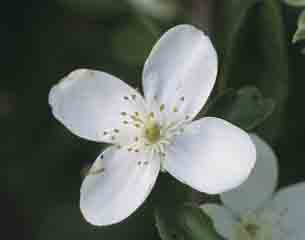

Home | Next | Previous | Index | Purchase book
Idaho Mountain Wildflowers
The Hydrangea Family, Hydrangeaceae
The Hydrangeaceae, a small family, consists of sixteen genera and about 250 species. Most grow in the north temperate zone. The family’s chief economic importance lies in various plants that are cultivated as ornamental trees and shrubs—probably the best known are species of Hydrangea and the mock oranges (Philadelphus spp.). Only one member of the family, Philadelphus lewisii—Idaho’s state flower—is native to Idaho. While Idahoans universally refer to the plant as the “syringa,” more correctly it should be known as Lewis’s mock-orange. It is an attractive, fragrant, white-flowered shrub or small tree that was unknown to science until Meriwether Lewis collected specimens of the plant. We do not know how the plant came to be known as a syringa; seemingly it was confused with the common lilac, another plant with fragrant flowers and hollow stems (The lilac, Syringa vulgaris, is a member of the olive family, Oleaceae. The word "syringa" is derived from syrinx, the Latin word for "tube.")
 |
Lewis’s mock orange, Philadelphus lewisii Pursh. Lewis collected the mock-orange on today’s Clearwater River on May 6, 1806, and again, on today’s Bitterroot River, on July 4, 1806. Apparently the mock orange was more common then than it is today. It still grows along the Clearwater, but in reduced numbers. Lewis noted, correctly, that the plant might be a Philadelphus. Syringas, as the plants are known in Idaho, are not hard to identify, for their fragrant flowers set them apart from the western dogwood, the only other tree with four-petaled flowers (the dogwood’s “petals” are actually bracts) with which it might be confused. The generic name, Philadelphus, was derived from two Greek words, philos for “love” and adelphos meaning “brother.” It is said to have been derived from the name of Ptolemy Philadelphus, an Egyptian king (283-247 B.C.). |
|
Home | Next | Previous | Index | Purchase book